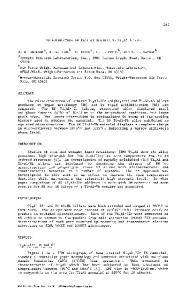Microstructure and Magnetic Properties of Ni 2 (Mn,Fe)Ga Heusler Alloys Rapidly Solidified by Melt Spinning
- PDF / 1,133,858 Bytes
- 10 Pages / 593.972 x 792 pts Page_size
- 17 Downloads / 349 Views
HE research on Ni2MnGa-based ferromagnetic shape memory alloys has been intense during the last decade owing to their application as a potential material in the field of sensors and actuators.[1,2] The microstructure, shape memory effect, magnetic properties, cycling characteristics, and ultrasound-induced martensitic transitions of Ni-Mn-Ga alloys have been studied.[3–5] However, it is difficult to manufacture these alloys in the form of thin plates or wires due to their limited ductility. The relatively high vapor pressure of manganese over its melt leads to composition variation during liquid metal processing of these alloys. Substituting Mn with Fe is of interest for commercialization. Earlier researchers explored the addition of different alloying additions to enhance the toughness of Ni2MnGa alloy while attempting to retain its magnetic and thermoelastic properties.[6,7] Although the effect of different elements has been studied in the Ni-Mn-Ga system, the open literature on the phase content and magnetic properties of rapidly solidified Ni-Mn-Ga alloys is limited.[8,9] Earlier studies on melt-spun Ni2MnGa alloys revealed the formation of martensite, nanocrystalline, and amorphous phases.[10,11] Ribbons of Ni2MnGa melt spun at high wheel speeds R.V.S. PRASAD, formerly Research Scholar with the Department of Metallurgical and Materials Engineering, Indian Institute of Technology Madras, Chennai- 600036, India, is now Visiting Scientist with the Korea Institute of Materials Science, Changwondaero, Seongsan-gu, Changwon, Gyeongnam 642-831, South Korea. M. SRINIVAS, Scientist C, and M. MANIVEL RAJA, Scientist F, are with the Advanced Magnetic Materials Group, Defence Metallurgical Research Laboratory, Hyderabad 500058, India. G. PHANIKUMAR, Associate Professor, is with the Department of Metallurgical and Materials Engineering, Indian Institute of Technology Madras. Contact e-mail: [email protected] Manuscript submitted January 31, 2011. METALLURGICAL AND MATERIALS TRANSACTIONS A
resulted in amorphous and nanocrystalline phases, and exhibited poor magnetic properties. The current study is based on the premise that possibilities offered by rapid solidification such as extended solid solubility and metastable microstructure formation could lead to interesting magnetic properties. In this study, substitution of iron in place of manganese is attempted to study its effect on structure and magnetic properties. The concentration of iron is varied (2, 5, 8, and 11 at. pct) while keeping the nominal composition close to Heusler composition.
II.
EXPERIMENTAL METHODS
A series of four alloys with compositions of Ni50 Mn(25 x)FexGa25 (x = 2, 5, 8, 11 at. pct) is prepared by arc melting of 99.99 pct pure nickel, manganese, iron, and gallium in argon atmosphere. Compositions will be referred to by their iron content for brevity. All composition values are given in at. pct, and the nominal and actual values detected by scanning electron microscope for energy dispersive analysis of X-rays (SEM-EDX) are listed in the Table I along with corr
Data Loading...











